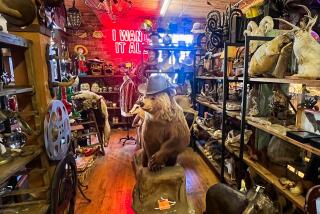Centennial fete for DeMille’s ‘Squaw Man’ at Hollywood Heritage Museum
Cecil B. DeMille was a master showman of a director whose films included such epics as 1927’s “The King of Kings,” 1934’s “Cleopatra” and 1956’s “The Ten Commandments.”
On Tuesday the Hollywood Chamber of Commerce is throwing a centennial celebration for his directorial debut, “The Squaw Man,” the first feature film shot in Hollywood by a major company. The festivities will take place at the Hollywood Heritage Museum in the historic Lasky-DeMille Barn, the former site of one of Hollywood’s first film studios.
“I don’t think anybody realized the impact ‘Squaw Man’ would have not just on Hollywood, but on the world of entertainment,” said Kaylee Kiecker, vice president of marketing and business development for the Hollywood Chamber of Commerce.
“They came out here [from New York] to make a movie, and it exploded into an entire industry that has become this huge machine that has evolved into changing entertainment as we know it.”
But the purpose of the party isn’t just to celebrate the 100th anniversary of “The Squaw Man,” the western drama starring Dustin Farnum and co-directed by DeMille with Oscar Apfel, but also to remind producers of the town’s legacy and continuing importance.
“Here we are 100 years later and we are tightly holding on to keep production in Hollywood,” Kiecker said. “It’s a little bit tragic in that sense that we are facing runaway production.”
The festivities will include vintage car displays, horses, photo stations, games and food. The event won’t actually include an official screening of “The Squaw Man,” the first production of the Jesse L. Lasky Feature Play Co., which was created in New York in summer 1913 by Lasky, a successful Broadway producer, Samuel Goldfish (later known as Samuel Goldwyn) as general manager and DeMille as director-general.
The film will be in a separate room on a loop, Kiecker said.
Betty Lasky, the 91-year-old daughter of Jesse Lasky, is scheduled to attend the event. Author Rosemary Lord will give a presentation on the beginnings of Hollywood.
“I will give a history of the Lasky Feature Play Co. and the making of ‘The Squaw Man,’” film historian Marc Wanamaker said. “And Mary Mallory will do a presentation on the barn itself.”
DeMille had leased the barn and studio facilities from L.L. Burns of the Burns and Revier Studio to make “The Squaw Man” for $250 a month. The barn was at the corner of Selma Avenue and Vine Street.
Two years after “Squaw Man,” Lasky’s company would merge with Adolph Zukor’s Famous Players Film Co. to become Famous Players-Lasky Corp. In 1918, the corporation folded its distributing subsidiary, Paramount Pictures, into the company.
DeMille would become one of the most powerful producers and directors in Hollywood. He remade “The Squaw Man” in 1931 but won the best film Oscar for his 1952 circus extravaganza, “The Greatest Show on Earth.”
The barn moved in 1926 to the back lot of United Studios, where Paramount was eventually built.
“It became a gym,” Wanamaker said. “People like Michael Landon worked out there.”
In 1956, Lasky and DeMille were at the dedication of the Lasky-DeMille Barn as Hollywood’s “first major film company studio,” which was designated California State Historical Landmark No. 554. After a few more moves, the Hollywood Chamber of Commerce and Paramount in 1983 donated the barn to Hollywood Heritage Inc., which operates the museum. The barn settled in its present location on Highland Avenue, on the south end of the Hollywood Bowl parking lot.
Twitter: @mymackie
--------------------
Centennial party for ‘The Squaw Man’
Where: Hollywood Heritage Museum, 2100 N. Highland Ave., Los Angeles
When: 5 to 8 p.m. Tuesday
Admission: $10; children under 10 are free
Information: https://www.hollywoodchamber.net/events
More to Read
Only good movies
Get the Indie Focus newsletter, Mark Olsen's weekly guide to the world of cinema.
You may occasionally receive promotional content from the Los Angeles Times.







